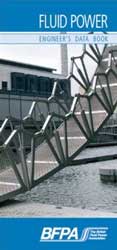
Posted to News on 4th Jul 2008, 16:57
Book review: BFPA 'Fluid Power - Engineer's Data Book'
The British Fluid Power Association (BFPA) has published a pocket book Fluid Power - Engineer's Data Book for fluid power system designers, engineers and students working on hydraulic or pneumatic applications. With its 'wipe clean' covers, spiral binding and heavyweight paper, the book will sit equally well on a designer's bookshelf or in a maintenance engineer's toolbox. Divided into three main sections, the book covers general information, hydraulics and pneumatic.

General
As the book points out, the main source of terms and definitions for fluid power systems is ISO 5598 Fluid power systems and components - Vocabulary, and the dozen or so terms defined in the Engineer's Data Book are likely to be known already by most readers. However, the conversion factors that are reproduced could well be useful, especially for users operating 'in the field', away from their desks, computers and online conversion utilities.
No less than eight pages are devoted to national, European and international standards, which is the type of information that will be useful from time to time.
Experienced practitioners will probably not find the coverage of hydraulic and pneumatic symbols useful, but students and less experienced designers will no doubt appreciate having this information to hand.
Elsewhere in the general section, there is information about associated electrical equipment, general formulae for pumps, motors, cylinders and flows, and a table and formulae relating to pressure losses and velocities through pipes. Again, having all of this together in one place is useful.
Hydraulics
A nomogram enables users to establish, for example, the cylinder diameter required to achieve a given output force from a defined hydraulic system pressure. In addition, the chart can be used to establish the maximum length of a piston rod for a given cylinder diameter and rod diameter.
For determining pipe sizes in relation to flow rates and recommended velocity ranges, readers can use either a second nomogram or the formula provided.
Formulae are also provided for performing calculations relating to accumulators, heating and cooling.
A further useful chapter in the hydraulics section covers hydraulic fluids, seals and contamination control.
Pneumatics
There is much less information in the book about pneumatics than hydraulics, though the following topics are included: pneumatic valve flow, cylinders, seals, filtration, lubrication and compressors.
Conclusion
At just over 50 pages, this pocket book contains a good amount of useful information, yet it remains conveniently sized. It also has space for users to add their own preferred formulae, references, supplier telephone numbers or other notes, so the book can become as near as possible a single source of fluid power information.
Copies of Fluid Power - Engineer's Data Book (reference P56, issue 7) can be ordered via the BFPA's website at www.bfpa.co.uk priced 4.50 - or 2.25 for BFPA members. If you visit the website, it is also worth downloading a copy of the BFPA's publications catalogue.
Jon Severn






























